Related Research Articles
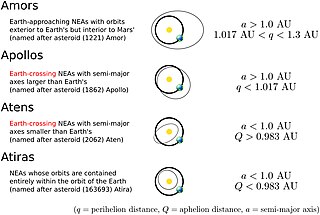
Atira asteroids or Apohele asteroids, also known as interior-Earth objects (IEOs), are Near-Earth objects whose orbits are entirely confined within Earth's orbit; that is, their orbit has an aphelion smaller than Earth's perihelion, which is 0.983 astronomical units (AU). Atira asteroids are by far the least numerous group of near-Earth objects, compared to the more populous Aten, Apollo and Amor asteroids.
(434326) 2004 JG6, provisional designation 2004 JG6, is an eccentric, sub-kilometer sized asteroid, classified as near-Earth object and potentially hazardous asteroid of the Atira group. It is one of the closest orbiting objects to the Sun. While its perihelion lies within the orbit of Mercury its orbital trajectory is highly elliptical, causing its aphelion to cross the orbit of Venus. Therefore, it does not fit the criteria for a vulcanoid or ꞋAylóꞌchaxnim asteroid, which would require it have a wholly intra-Mercurian and intra-Venusian orbit respectively.
1998 DK36 is a 30-meter sized asteroid and near-Earth object that is possibly the first Apohele asteroid (Atira) – an asteroid that is always closer to the Sun than Earth – detected. It was first observed on 23 February 1998, by David J. Tholen at Mauna Kea Observatory, Hawaii, but is now considered a lost minor planet.
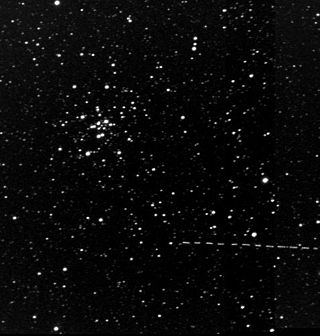
(33342) 1998 WT24 is a bright, sub-kilometer asteroid, classified as near-Earth object and potentially hazardous asteroid (PHA) of the Aten group, located in Venus's zone of influence that has frequent close encounters with Mercury, Venus, and Earth. It made a close approach to Earth on 11 December 2015, passing at a distance of about 4.2 million kilometers (2.6 million miles, 11 lunar distances) and reaching about apparent magnitude 11.
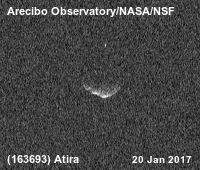
163693 Atira (; provisional designation 2003 CP20) is a stony asteroid, dwelling in the interior of Earth's orbit. It is classified as a near-Earth object. Atira is a binary asteroid, a system of two asteroids orbiting their common barycenter. The primary component with a diameter of approximately 4.8 kilometers (3 miles) is orbited by a minor-planet moon that measures about 1 km (0.6 mi). Atira was discovered on 11 February 2003, by astronomers with the Lincoln Near-Earth Asteroid Research at Lincoln Laboratory's Experimental Test Site near Socorro, New Mexico, in the United States.

(311999) 2007 NS2 is an asteroid and Mars trojan orbiting near the L5 point of Mars.

(276033) 2002 AJ129, provisional designation 2002 AJ129, is a Mercury-crossing asteroid. It has the ninth-smallest perihelion of all numbered asteroids, after asteroids such as 2000 BD19, 2004 UL, and 2008 XM. It makes close approaches to all of the inner planets and asteroid 4 Vesta. The asteroid is estimated to be between 0.5–1.2 kilometers (0.3–0.7 mi) across. In January 2018 there was much media hype about this asteroid being classified as a potentially hazardous asteroid, although there is no known threat of an impact for hundreds if not thousands of years. The media has compared the size of the asteroid to the Burj Khalifa in Dubai.
2004 BX159, is an asteroid from the central region of the asteroid belt, approximately 1.2 kilometers in diameter. It was first observed at Paranal Observatory in the Atacama desert of Chile on 20 January 2004. 2004 BX159 missed the virtual impactor date of 29 August 2009. The asteroid was removed from the Sentry Risk Table in April 2014 as a result of precovery images establishing it is a harmless main belt asteroid.

2012 BX34 is a small Aten asteroid that made one of the closest recorded asteroid close approaches of Earth on 27 January 2012. It passed within 0.0004371 AU (65,390 km; 40,630 mi) of Earth during its closest approach at 15:25 GMT. 2012 BX34 measures around 8 meters (26 ft) across; if it had impacted in 2012, it would have been too small to pass through Earth's atmosphere intact.

2013 JX28 (also known as 2006 KZ39) is an Atira asteroid, a type of Aten asteroid, that orbits entirely within Earth's orbit. It orbits very close to the Sun, having the eighth smallest semi-major axis of any minor planet in the Solar System. At its closest, it is only 0.26 AU (39,000,000 km; 24,000,000 mi) from the Sun, but more than 100 minor planets have a smaller perihelion distance.

2005 HC4 is the asteroid with the smallest known perihelion of any known object orbiting the Sun (except sungrazing comets). Its extreme orbital eccentricity brings it to within 0.071 AU of the Sun (23% of Mercury's perihelion) and takes it as far as 3.562 AU from the Sun (well beyond the orbit of Mars). Due to its very small perihelion and comparably large aphelion, 2005 HC4 achieves the fastest speed of any known asteroid bound to the Solar System with a velocity of 157 km/s (565,000 km/h; 351,000 mi/h) at perihelion (there are comets, however, which obtain much higher speeds).
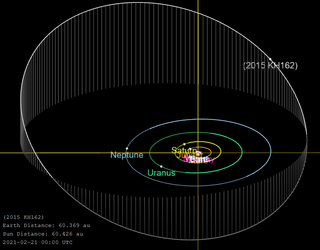
(674118) 2015 KH162 is a large trans-Neptunian object orbiting in the scattered disc region of the outermost Solar System. First observed in 2015, this minor planet is one of the most distant objects from the Sun at 60.6 AU, or twice as far as Neptune.
(543354) 2014 AN55 (provisional designation 2014 AN55) is a trans-Neptunian object in the scattered disc, located in the outermost region of the Solar System, that measures approximately 600 kilometres (370 mi) in diameter. It was discovered on 25 January 2014, by astronomers with the Pan-STARRS survey at Haleakala Observatory on the island of Maui, Hawaii, in the United States.
2017 MB7 is a trans-Neptunian object and damocloid on a cometary-like orbit from the outer Solar System, approximately 6 kilometers (4 miles) in diameter. It was first observed on 22 June 2017 by the Pan-STARRS survey at Haleakala Observatory in Hawaii, United States. This unusual object has the largest heliocentric aphelion, semi-major axis, orbital eccentricity and orbital period of any known periodic minor planet, even larger than that of 2014 FE72; it is calculated to reach several thousand AU (Earth-Sun) distances at the farthest extent of its orbit.

2019 AQ3 is an inclined near-Earth object of the small Atira group from the innermost region of the Solar System, estimated to measure 1.4 kilometers (0.9 miles) in diameter. Among the hundreds of thousands known asteroids, 2019 AQ3's orbit was thought to have likely the smallest semi-major axis (0.589 AU) and aphelion (0.77 AU), that is, the orbit's average distance and farthest point from the Sun, respectively. The object was first observed on 4 January 2019, by astronomers at Palomar's Zwicky Transient Facility in California, with recovered images dating back to 2015.
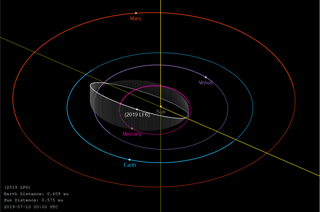
2019 LF6 is a near-Earth object of the Atira group. After 2021 PH27, it has the second-smallest semi-major axis among the known asteroids (0.555 AU), beating the previously-held record of 2019 AQ3. It orbits the Sun in 151 days.

594913 ꞌAylóꞌchaxnim (provisional designation 2020 AV2) is a large near-Earth asteroid discovered by the Zwicky Transient Facility on 4 January 2020. It is the first asteroid discovered to have an orbit completely within Venus's orbit, and is thus the first and only known member of the eponymous ꞌAylóꞌchaxnim (informally named Vatira before its discovery) population of Atira-class asteroids. ꞌAylóꞌchaxnim has the smallest known aphelion and third-smallest known semi-major axis among all asteroids. With an absolute magnitude approximately 16.2, the asteroid is expected to be larger than 1 km in diameter.
2021 PH27 is a near-Earth asteroid of the Atira group. It was discovered by Scott Sheppard using the Dark Energy Survey's DECam imager at NOIRLab's Cerro Tololo Inter-American Observatory on 13 August 2021. 2021 PH27 has the smallest semi-major axis and shortest orbital period among all known asteroids as of 2021, with a velocity at perihelion of 106 km/s (240,000 mph). It also has the largest relativistic perihelion shift of any object orbiting the Sun, 1.6 times that of Mercury. With an absolute magnitude of 17.7, the asteroid is estimated to be larger than 1 kilometer (0.6 miles) in diameter.
2015 DR215 is a stony near-Earth asteroid of the Atira class residing within Earth's orbit. It was discovered on 18 February 2015 by the Pan-STARRS 1 survey at Haleakalā Observatory at Maui, Hawaiʻi. The asteroid has a diameter of about 200 m (660 ft) and makes close approaches within 0.05 AU (7.5 million km; 4.6 million mi) of Earth, making it a potentially hazardous object. On 11 March 2022, it made a close approach 0.045 AU (6.7 million km; 4.2 million mi) from Earth, reaching a peak apparent magnitude of 17 as it streaked across the southern sky.
2021 RR205 is an extreme trans-Neptunian object discovered by astronomers Scott Sheppard, David Tholen, and Chad Trujillo with the Subaru Telescope at Mauna Kea Observatory on 5 September 2021. It resides beyond the outer extent of the Kuiper belt on a distant and highly eccentric orbit detached from Neptune's gravitational influence, with a large perihelion distance of 55.5 astronomical units (AU). Its large orbital semi-major axis (~1,000 AU) suggests it is potentially from the inner Oort cloud. 2021 RR205 and 2013 SY99 both lie in the 50–75 AU perihelion gap that separates the detached objects from the more distant sednoids; dynamical studies indicate that such objects in the inner edge this gap weakly experience "diffusion", or inward orbital migration due to minuscule perturbations by Neptune. While Sheppard considers 2021 RR205 a sednoid, researchers Yukun Huang and Brett Gladman do not.
References
- 1 2 3 "459883 (2014 JX55)". Minor Planet Center. Retrieved 15 November 2019.
- 1 2 3 4 5 "JPL Small-Body Database Browser: 459883 (2014 JX55)" (2018-06-06 last obs.). Jet Propulsion Laboratory . Retrieved 15 November 2019.
- ↑ "Asteroid Size Estimator". CNEOS NASA/JPL. Retrieved 15 November 2019.
- 1 2 "MPEC 2007-E56 : 2007 EB26". Minor Planet Center. 12 March 2007. Retrieved 15 November 2019. (K07E26B)
- ↑ List of asteroids with q<0.3075 AU generated by the JPL Small-Body Database Search Engine Retrieved 2013-05-18
- ↑ Cranmer, Steven R. (2016). "Predictions for Dusty Mass Loss from Asteroids During Close Encounters with Solar Probe Plus". Earth, Moon, and Planets. 118 (2–3): 5. arXiv: 1606.01785 . doi:10.1007/s11038-016-9490-5. S2CID 64651157.
- ↑ "Asteroid (459883) 2014 JX55". AstDyS-2, Asteroids – Dynamic Site. Retrieved 15 November 2019.